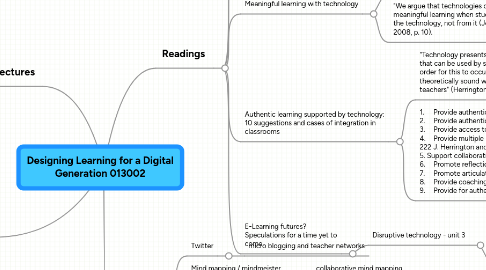
1. Lectures
1.1. TPACK
1.2. Digital natives
1.3. Technology integration matrix
1.4. emancipative learning
1.5. WEB 2.0
1.6. Personal learning network
1.7. Delicious
1.8. Twitter
1.9. Google sites
1.10. Blogs
2. Self paced learning
3. Readings
3.1. Gears of my childhood
3.1.1. "The computer is the Proteus of machines. Its essence is its universality, its power to simulate. Because it can take on a thousand forms and can serve a thousand functions, it can appeal to a thousand tastes" (Papert, 1980 p. 2).
3.2. Too cool for school? No way! (TPACK Framework)
3.2.1. The idea of creative repurposing is important because most technolo- gies that teachers use typically have not been designed for educational purposes. Technologies including standard productive or office soft- ware, blogs, wikis, and GPS systems were not designed for teachers, and as such, teachers must repurpose them for use in educational contexts. Such repurposing is possible only when the teacher knows the rules of the game and is fluent enough to know which rules to bend, which to break, and which to leave alone (Mishra & Koehler, 2009, p. 16).
3.3. Meaningful learning with technology
3.3.1. "In order for students to learn meaningfully, they must be willfully engaged in a meaningful task. In order for meaningful learning to occur, the task that students pursue should engage active, constructive, intentional, authentic, and cooperative activities (Jonassen, et al. 2008, p. 2)
3.3.2. "We argue that technologies can support meaningful learning when students learn with the technology, not from it (Jonassen, et al. 2008, p. 10).
3.4. Authentic learning supported by technology: 10 suggestions and cases of integration in classrooms
3.4.1. "Technology presents the opportunity to employ powerful cognitive tools that can be used by students to solve complex and authentic problems. In order for this to occur, however, technology needs to be used in theoretically sound ways, and it needs to be used by students rather than teachers" (Herrington & Kervin, 2007, p. 219).
3.4.2. 1. Provide authentic contexts that reflect the way the knowledge will be used in real life (e.g. Brown et al., 1989; Collins, 1988; Gulikers, Bastiaens, & Martens, 2005) 2. Provide authentic activities (e.g. Brown et al., 1989; Cognition and Technology Group at Vanderbilt, 1990; Jonassen, 1991; Young, 1993) 3. Provide access to expert performances and the modelling of processes (e.g. Collins et al., 1989; Lave & Wenger, 1991) 4. Provide multiple roles and perspectives (e.g. Bransford, Sherwood, Hasselbring, Kinzer, & Williams, 1990; Honebein, Duffy, & Fishman, 1993; Lave & Wenger, 1991; Spiro, Feltovich, Jacobson, & Coulson, 1991) 222 J. Herrington and L. Kervin 5. Support collaborative construction of knowledge (e.g. Bransford et al., 1990; Brown et al., 1989) 6. Promote reflection to enable abstractions to be formed (e.g. Boud, Keogh, & Walker, 1985; Norman, 1993) 7. Promote articulation to enable tacit knowledge to be made explicit (e.g. Lave & Wenger, 1991; Pea, 1991; Vygotsky, 1978) 8. Provide coaching by the teacher at critical times, and scaffolding and fading of teacher support (e.g. Collins, 1988; Collins et al., 1989; Greenfield, 1984; Harley, 1993) 9. Provide for authentic, integrated assessment of learning within the tasks (e.g. Gulikers, Bastiaens, & Kirschner, 2004; Herrington & Herrington, 1998; McLellan, 1993; Reeves & Okey, 1996; Young, 1993, 1995).
3.5. E-Learning futures? Speculations for a time yet to come.
3.5.1. Disruptive technology - unit 3
3.5.1.1. "a disruptive innovation or technology is one that eventually takes over the existing dominant technology in the market, despite the fact that the disruptive technology is both radically different from the leading technology and that it often initially performs less successfully than the leading technology according to existing measures of performance, but over time the functionality or the attributes of the new way of doing things replace the older technologies (Hedberg, 2006, p. 173).
4. Tutorials
4.1. Twitter
4.1.1. micro blogging and teacher networks
4.2. Mind mapping / mindmeister
4.2.1. collaborative mind mapping
4.3. Delicious
4.3.1. Social bookmarking
4.4. Voicethread
4.4.1. collaborative audio / visual blogging
